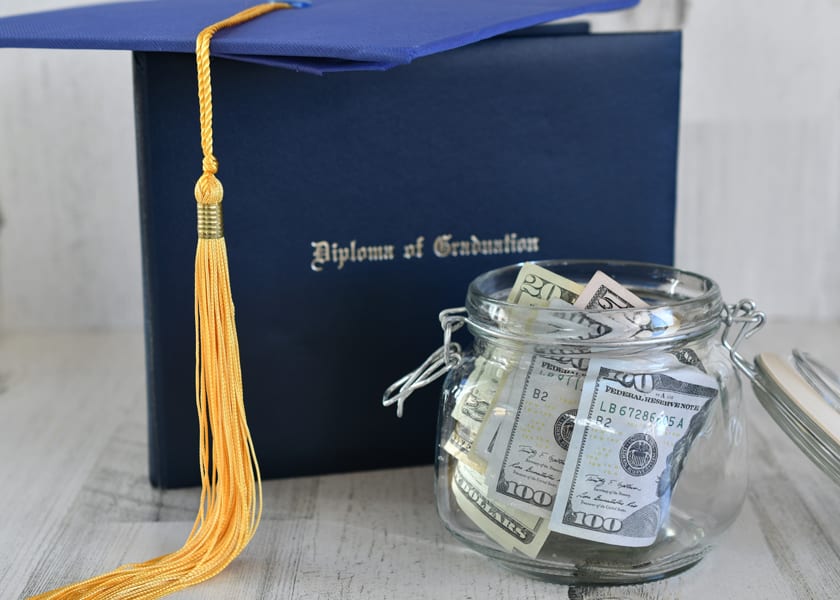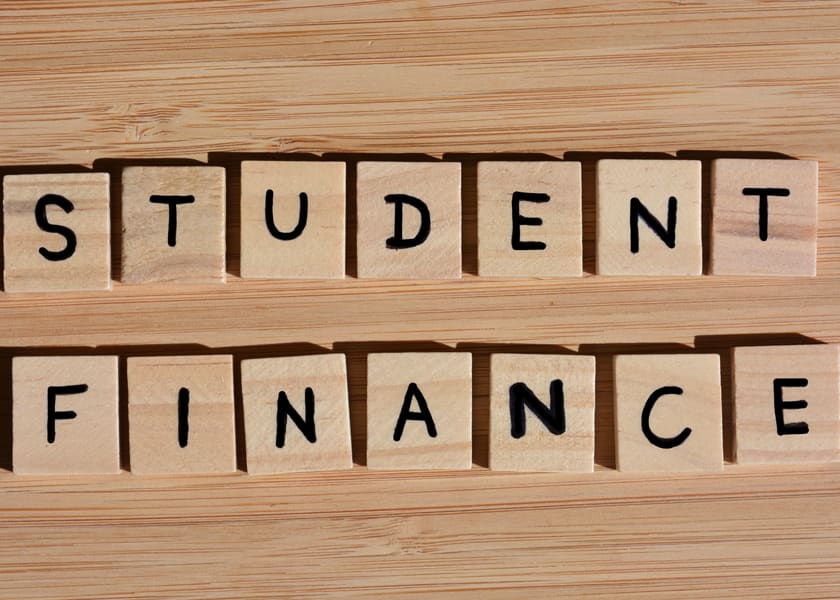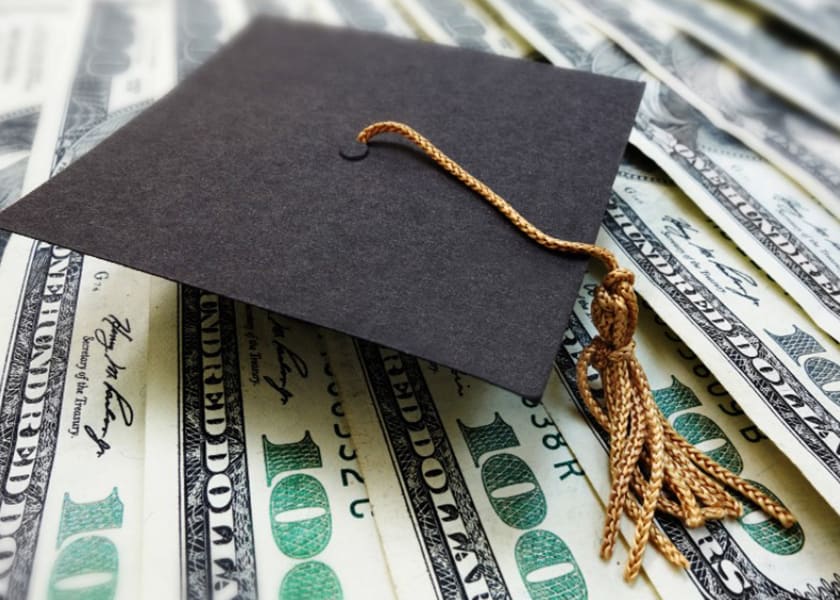Best Student Loan Provider
Credible 
Compare Rates from Multiple Lenders
- Check Pre Qualified Rates in 2 Min.
- Compare From 9 Top Lenders
- Does Not Affect Your Credit Score*
- Easiest Online Process
Public Service Loan Forgiveness (PSLF)
The U.S department of education has designed the public service loan forgiveness (PSLF) program to provide debt relief for students who work in government or other nonprofit organizations following graduation. Eligible borrowers must have begun working at an eligible employer, then made 120 qualifying payments under one of these repayment plans:
• Income-based repayment plan (IBR)
The monthly payment is based on the borrower's family size and income, as well as the total amount of federal student loans that he or she borrowed. For example, if you earn $30,000 per year and your spouse earns $40,000 per year while attending school full-time, your combined annual income would be $70,000. Under the IBR plan, you'll be required to pay 15 percent of your discretionary income toward your student loans, in this case $9,500. Your remaining monthly payment under the IBR would total $4,500.
• Pay As You Earn repayment plan (PAYE)
The monthly payment is calculated by taking into account only 10 percent of the borrower's discretionary income while enrolled in school full-time. For example, if you are married and earn a combined annual salary of $45,000 -- again working part-time while attending school full-time -- your monthly payment would total $451 per month under PAYE.
• Standard repayment plan
The monthly payment is a fixed amount that does not vary over the life of the loan, typically 10 years.
Your employment must be with one of these specific types of employers to qualify for PSLF: government organizations at any level, tax-exempt charitable organizations that are not religious or educational institutions, AmeriCorps, or the Peace Corps.
You cannot have an existing contract with your employer at the time you apply for forgiveness; however, if you are employed by one of these organizations when you sign up for public service loans, you automatically will receive credit toward your 120 qualified payments. You can consolidate federal student loans under both income-based plans and standard repayment plans to take advantage of this benefit. If
• Income contingent repayment plan (ICR)
This program calculates payments based on 20 percent of the borrower's discretionary income, which will result in a smaller monthly payment than both IBR and PAYE. However, if your loan is large enough that you owe more money on it each month under this plan than under standard repayment, you will end up paying more over time because you'll be required to repay your loans for a longer period of time.
• Income-sensitive repayment plan (ISR)
This program calculates payments based on 20 percent or 25 percent of the borrower's income at the time of application for discharge of school loans. There are no restrictions related to which type of organization you work for while enrolled in college full-time. Again, these plans will result in higher monthly payments than if your student loan had been repaid under standard repayment.
• Standard repayment plan for federal and private loans
If you received a student loan from a bank or other financial lender, your lender might offer only the standard repayment plan as an option. You can consolidate your private loans to receive credit toward student loan forgiveness on an income-based plan. However, if you're employed by an eligible employer at the time of consolidation, such as AmeriCorps or Peace Corps, you may apply for public service loan forgiveness after making 120 qualified payments while enrolled full-time in school.
Teachers often find their way into debt through advanced degrees required for licensure; however, federal and state governments have created programs designed specifically to assist teachers who meet certain criteria with their student loans. Of the 10 student loan forgiveness programs listed below, seven are specifically designed to reduce federal Perkins Loans for teachers (identified with an asterisk).
• Perkins Loan cancellation for teachers employed in low-income schools
If you qualify, the U.S. Department of Education will cancel up to 100 percent of your Perkins Loans after five years or 60 months of full-time employment as a teacher working in a school serving students from low-income families. There is no financial eligibility test to take; rather, qualifying teachers automatically receive this benefit by meeting the required service obligation.
• Teacher loan forgiveness through TEACH Grant program
This program assists preK-12 educators with their college expenses if they agree to teach full time at a low-income public or private elementary or secondary school for at least four academic years. You can receive up to $4,000 per year as a TEACH Grant recipient and have up to 80 percent of your grant converted into a Perkins Loan cancellation for each qualifying year you teach.
This program requires applicants to complete a FAFSA and pass a financial literacy course. You must maintain satisfactory academic progress according to the terms of the program while enrolled in a teacher education program, which typically lasts four years.
However, if you do not obtain full-time employment as a teacher within eight years, you will be required to repay any outstanding TEACH Grants with interest at 10 percent annually. In addition, anyone who false statements regarding eligibility requirements of this program must repay the grant with interest at 10 percent annually.
• Perkins Loan cancellation through service in AmeriCorps or Peace Corps
If you serve in either organization, the government will cancel 15 percent of your Perkins Loans for each year of full-time service. This benefit can be applied toward a maximum of 70 percent of your total loan amount when combined with other student loan forgiveness programs.
• Perkins Loan cancellation if employed by eligible employers
If you qualify for public sector or nonprofit employment that serves low-income families and their children, the U.S. Department of Education will offer up to 100 percent forgiveness on your federal Perkins Loans after five years or 60 months of continuous employment a qualifying setting while enrolled in school at least half-time.
• Private loan cancellation for teachers employed in low-income schools or by eligible employers
If you teach full-time at a public or private elementary or secondary school for five consecutive years, the U.S. Department of Education will cancel up to 100 percent of your remaining federal student loans (excluding consolidation loans) and 100 percent of your private education loans.
This program requires applicants to complete an eligibility form verifying employment while enrolled in graduate school, including signatures from the school's financial aid office and employer. If you did not borrow your loan directly from the lender, you will need to supply documents indicating that they received permission to release information about your loan(s). You'll also need evidence that you are currently enrolled at least half-time in graduate school.
• Perkins Loan cancellation through service in an underserved area
If you plan to teach full-time at a public or private elementary or secondary school in a designated underserved area, the U.S. Department of Education will cancel up to 100 percent of your outstanding Perkins Loans after five years or 60 months of continuous employment while enrolled in school at least half-time.
This program also requires applicants to complete an eligibility form verifying employment while enrolled in graduate school, including signatures from the school's financial aid office and employer. If you did not borrow your loan directly from the lender, you will need to supply documents indicating that they received permission to release information about your loan(s). You'll also need evidence that you are currently enrolled at least half-time in graduate school.
This program requires an application, which is available on the website of your loan servicer or through the Department of Education's student financial aid office. You must provide proof of full-time employment while enrolled in school at least half-time and maintain satisfactory academic progress according to the terms of your current program.
If you do not complete your educational program because you withdraw from class(es) or for other reasons, you will be required to repay any outstanding Perkins Loans with interest at 10 percent annually. In addition, anyone who false statements regarding the eligibility requirements of this program must repay the grant with interest at 10 percent annually. Any Perkins Loan cancellation under this provision will be reported to the credit bureaus and may impact your ability to obtain future student loans.
• Loans for high-level national competition athletes
The National Collegiate Athletic Association (NCAA) sponsors a number of educational programs, including the Division I Student-Athlete Opportunity Fund and the Student Assistance Fund.
These two funds provide financial assistance to student-athletes who have exhausted their athletic eligibility because they left school early to turn professional in their sports or because they sustained career-ending injuries while competing on an NCAA team.
The NCAA will waive its usual rule that requires students with remaining athletics eligibility to take at least one class per term and maintain good academic standing in order to receive scholarship money from these funds.
Most national governing bodies for U.S. Olympic sports provide similar loan assistance for athletes who compete in the Olympics and other international competitions. Contact your national governing body for details.
• Federal Perkins Loan cancellation by teaching service in a "high-need area."
The U.S. Department of Education will cancel up to 100 percent of your outstanding Federal Perkins Loans if you teach full time at a public or private elementary or secondary school that serves students from low-income families or at a public or nonprofit adult educational institution that serves as a "substantial source" of income for the local community's most disadvantaged residents, including high school dropouts, parolees and individuals with disabilities over age 21 who have not completed their secondary education requirements as required by law.
This program also requires an application, which is available through the U.S. Department of Education's Federal Student Aid Office or your loan servicer if you borrowed your loan directly from them.
This program requires an application, which is available on the website of your loan servicer or through the Department of Education's student financial aid office. If you did not borrow your Federal Perkins Loan directly from the lender, you will need to supply documents indicating that they received permission to release information about your loan(s). You'll also need evidence that you are currently teaching at least half-time in a designated high-need area and maintain satisfactory academic progress according to the terms of your current program.
If you do not complete your educational program because you withdraw from class(es) or for other reasons, you will be required to repay any outstanding Perkins Loans with interest at 10 percent annually. Any Perkins Loan cancellation under this provision will be reported to the credit bureaus and may impact your ability to obtain future student loans.
• Student loan repayment assistance programs (LRAPs)
Many states or cities offer Loan Repayment Assistance Programs that cover job-related student loans with state or local government funds. For example, New York State offers an LRAP program through its Higher Education Services Corporation for teachers who work in qualifying schools in the state's metropolitan areas.
Similarly, Connecticut offers an education loan repayment program through its Department of Higher Education for physicians who practice in the state after graduation, while Washington state provides similar opportunities to medical and dental students who agree to practice in the state for 10 years.
• Federal repayment assistance programs
The U.S. government offers several student loan forgiveness programs that will cancel federal loans or reduce monthly payments based on your service or job type. These include the Teachers Loan Forgiveness Program, which forgives up to $17,500 of Subsidized Stafford Loans and Unsubsidized Stafford Loans for elementary and secondary school teachers who work full time for five consecutive years within low-income schools; Perkins Loan cancellation through teaching at a Title I school; Public Service Loan Forgiveness (PSLF).
This erases remaining federal loan balances after 120 qualifying monthly payments under certain repayment plans while working full time in public service jobs; and the federal student loan repayment program for doctors and nurses who accept positions with the U.S. Department of Health and Human Services, Indian Health Service or a tribal contract health services provider
• Division 1A Athletic Organization Loan Repayment Assistance Program
Division I athletes participating in their respective sports in certain intercollegiate athletic programs may be eligible to have up to $10,000 of outstanding principal and interest repaid on an eligible subsidized or unsubsidized Federal Stafford Loan or Federal Direct Unsubsidized Loan if they meet certain conditions (such as making satisfactory progress toward graduation).
Eligible loans include Regular Unsubsidized Loans, Grad PLUS Loans, and Consolidation loans that do not include Parent PLUS Loans. This program is not available for PLUS loans made to parents or Graduate Plus Loans.
• National Health Service Corps (NHSC) Loan Repayment Program
This program will repay up to $30,000 in federal student loan debt per calendar year for full-time physicians and dentists who agree to provide primary health care services in federally designated Health Professional Shortage Areas (HPSAs). The NHSC started the Loan Repayment Program in 1979 and it is funded by the U.S Department of Health and Human Services.
Physicians must be board certified and meet practice requirements such as minimum hours spent providing direct patient care each week, no history of disciplinary action or unresolved complaints, screening for controlled substance use, and criminal background checks.
• AmeriCorps Program
Through the AmeriCorps program, participants may earn up to an additional $17,500 of student loan forgiveness for successfully completing a term of service—about a year or more. Cancellation amounts are tiered by the number of terms completed and range from 15 percent of your total eligible federal student loans for one term of service to complete cancellation after four terms.
In return for their time, participants get a Segal AmeriCorps Education Award that can go toward future educational costs or be used as a down payment on certain home mortgages under the Homeownership Opportunities for Service Members (HOSM) program.
To be eligible for any assistance, participants must be U.S. citizens, nationals or eligible permanent residents; enroll in a qualifying repayment plan and have a demonstrated financial need for the assistance under the terms of their individual service agreement.
Conclusion
There are a variety of student loan forgiveness programs available to those who qualify. These include the Teachers Loan Forgiveness Program, Perkins Loan cancellation through teaching at a Title I school, Public Service Loan Forgiveness (PSLF), and the federal student loan repayment program for doctors and nurses who accept positions with the U.S. Department of Health and Human Services, Indian Health Service or a tribal contract health services provider.
Division 1A Athletic Organization Loan Repayment Assistance Program is also available to athletes participating in certain intercollegiate athletic programs. Additionally, participants in the AmeriCorps program may earn up to an additional $17,500 of student loan forgiveness for successfully completing a term of service.













